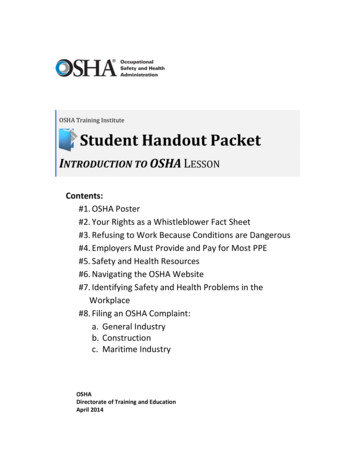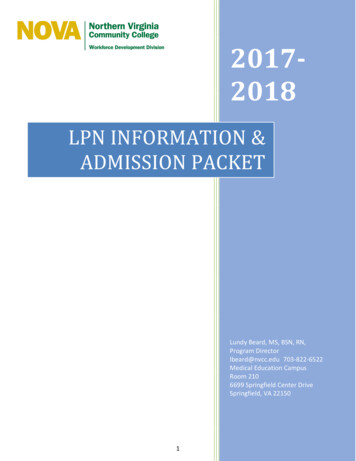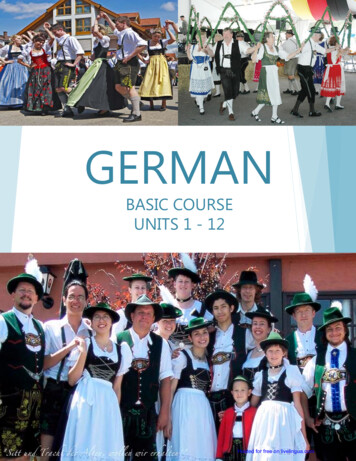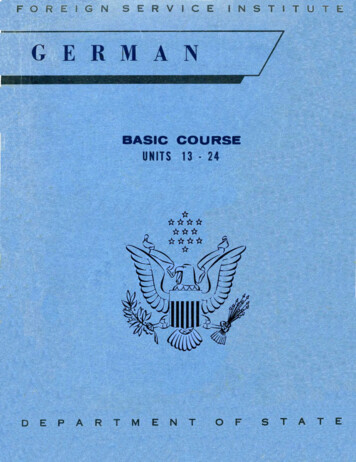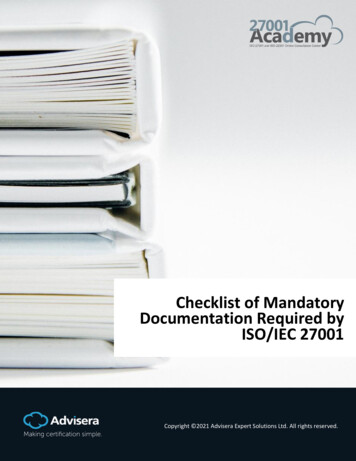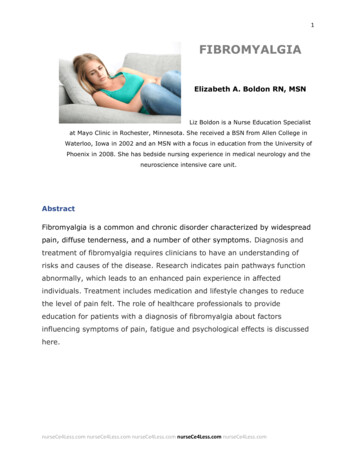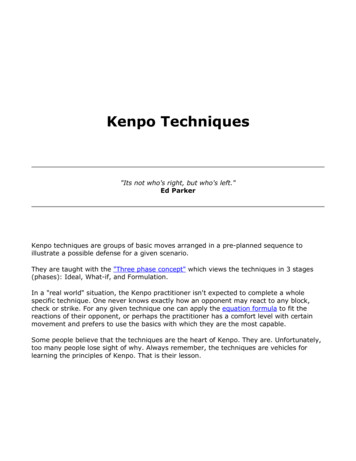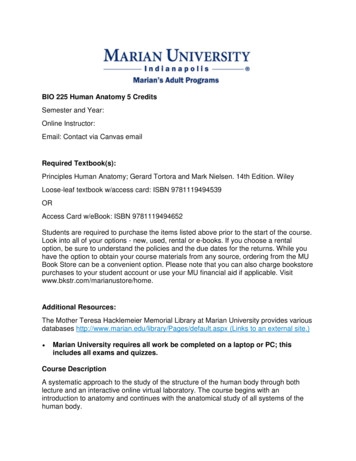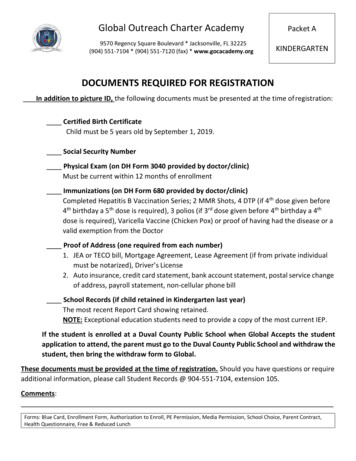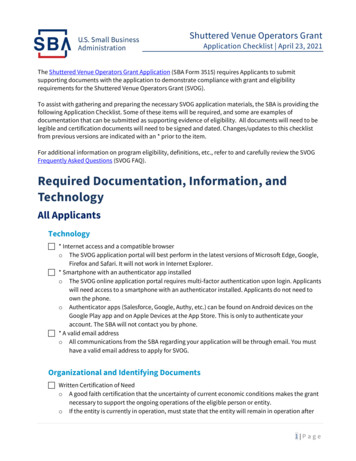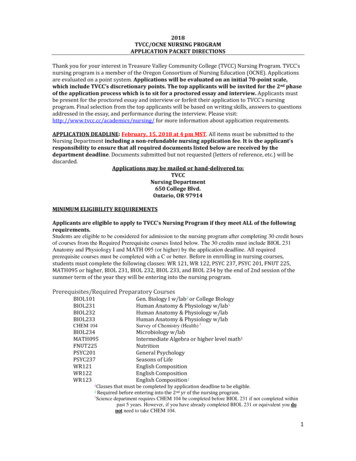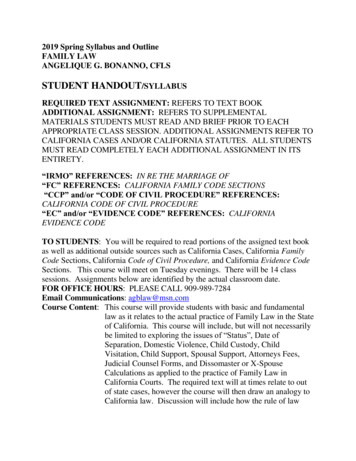
Transcription
2019 Spring Syllabus and OutlineFAMILY LAWANGELIQUE G. BONANNO, CFLSSTUDENT HANDOUT/SYLLABUSREQUIRED TEXT ASSIGNMENT: REFERS TO TEXT BOOKADDITIONAL ASSIGNMENT: REFERS TO SUPPLEMENTALMATERIALS STUDENTS MUST READ AND BRIEF PRIOR TO EACHAPPROPRIATE CLASS SESSION. ADDITIONAL ASSIGNMENTS REFER TOCALIFORNIA CASES AND/OR CALIFORNIA STATUTES. ALL STUDENTSMUST READ COMPLETELY EACH ADDITIONAL ASSIGNMENT IN ITSENTIRETY.“IRMO” REFERENCES: IN RE THE MARRIAGE OF“FC” REFERENCES: CALIFORNIA FAMILY CODE SECTIONS“CCP” and/or “CODE OF CIVIL PROCEDURE” REFERENCES:CALIFORNIA CODE OF CIVIL PROCEDURE“EC” and/or “EVIDENCE CODE” REFERENCES: CALIFORNIAEVIDENCE CODETO STUDENTS: You will be required to read portions of the assigned text bookas well as additional outside sources such as California Cases, California FamilyCode Sections, California Code of Civil Procedure, and California Evidence CodeSections. This course will meet on Tuesday evenings. There will be 14 classsessions. Assignments below are identified by the actual classroom date.FOR OFFICE HOURS: PLEASE CALL 909-989-7284Email Communications: agblaw@msn.comCourse Content: This course will provide students with basic and fundamentallaw as it relates to the actual practice of Family Law in the Stateof California. This course will include, but will not necessarilybe limited to exploring the issues of “Status”, Date ofSeparation, Domestic Violence, Child Custody, ChildVisitation, Child Support, Spousal Support, Attorneys Fees,Judicial Counsel Forms, and Dissomaster or X-SpouseCalculations as applied to the practice of Family Law inCalifornia Courts. The required text will at times relate to outof state cases, however the course will then draw an analogy toCalifornia law. Discussion will include how the rule of law
differs or remains the same as applied in California Family LawCourts.This course will encompass not only required text andsupplemental reading assignments which must be read and fullybriefed before each session, but it will also provide an everyday application of the law to specific fact patterns.Students will also receive actual Judicial Council Forms whichare used in California Family Courts. Judicial Council Formswill be distributed so that each student will have essentially asample “start to finish” Divorce Package by the end of thecourse. Students will also receive several sample X-Spousecalculations when issues of support are addressed so they canfamiliarize themselves with the forms and understand how itapplies to a Family Law Case.Throughout the course and at varying times, (when timepermits) an “RFO” (Request for Order) fact pattern will bedistributed to students regarding certain topics covered in thecourse curriculum. Students will then be required to participatein an in-class mock Request For Order hearing. They will bedesignated as the attorney for either the Petitioner or theRespondent. They will then be required to argue the case basedupon whom they represent. The Professor will act as theJudicial Officer asking questions during the presentation andrequiring students to participate in a mock Court appearance.This will give students an idea of what it is like to actuallypractice and argue a Family Law case. Participation in thisprocess is mandatory.Finally, students will receive extensive anecdotes from theprofessor of actual Family Law cases and how the law wasapplied to the particular set of facts. Students will receiveinformation as to how the various Family Law Courts are thesame and how they differ from county to county in the SouthernCalifornia region. Students will receive information about localJudicial Officers and recommendations as to how to besuccessful when arguing a Family Law case in Court. Studentswill learn about how to assist and manage a client who is goingthrough a divorce, how to give clients reasonable expectationsabout their cases, when to mediate and when to litigate a case,and how to handle challenging clients. Time permitting, andbased upon availability, Professor reserves the right to bring in
a guest speaker, specifically a local San Bernardino CountyFamily Law Judicial Officer.This is NOT a Community Property Course. While there maybe some discussion as to minor property issues, that is not thesubject of this course.Course Objectives:To introduce students the fundamentals and legalprinciples of California Family Law, statutory law, case law,and California Judicial Council Forms.To articulate the law and then apply propositions of CaliforniaFamily Code to real and hypothetical fact patterns.To participate in mock Court appearances by reviewing a factpattern and thereafter being assigned as the attorney for eitherthe Petitioner or the Respondent to argue the case before peers.The student will make a formal “appearance” and then arguethe case in the setting of a mock Request for Order Courthearing.Competently identify and resolve issues in a Family Law matterand prepare students to be able to handle a case from start tofinish upon receiving admission to the California State Bar.Class Expectations:This course covers extensive material as it relates toCalifornia Family Law. It will not be possible to explore everyarea of the law, but it will be extensive. Review and briefing ofthe course material (including additional reading assignments)is mandatory. Each student is expected to read and brief all theapplicable assignments before coming to class.BOOK BRIEFING OR CANNED BRIEFS ARE NOTALLOWED.Students are expected to be present at each class session. Classattendance will be taken at the beginning of each class. Tardystudents may expect to receive either a ½ absence or fullabsence as permitted in Administrative Guidelines.Each student may be required to participate in the mockRequest for Order hearing. Participation will vary dependingon amount of time expended in each class session.Students who are not prepared for class may be marked asabsent as per Administrative Guidelines. Students should be
on time for class and be prepared to remain in class for theentire session. Cell phone use is not permitted in class.Professor will use a Socratic Method. Students should beprepared to brief cases by identifying the Issue, Rule, Analysis,and Conclusion of each case. All students should be preparedto answer questions about the case even if they are not calledupon to “brief” the case.Class work must be your OWN work. While students areencouraged to study together outside of classroom time, youmust do your own work.The final objective is intended to provide legal principles andpractical applications about the actual practice of law this field.Students will learn the black letter law as it applies toCalifornia. They will then learn how to apply said law tovarious fact patters and changes in the fact patterns. They willthen be given an opportunity to argue as case in a mock hearingsetting.Respect of Others:There is no talking in class to other students. This isdisruptive to others who are listening to the lecture. Studentsshould use every effort to remain in class for the duration of theclass and not leave during the lecture as this is also disruptive toother students. If student needs to leave the classroom, it isrequested you do so quietly. Students who leave class early anddo not return may be marked absent. Students are stronglyencouraged to ask questions throughout lectures on any theorypresented in the course. Students should raise their hand ifthere are questions.Academic Integrity:Plagiarism or other fraudulent reprehension relative tothe originality of any part of any academic requirement in thecourse is not permitted. All course work must be that of theindividual student. Use of “canned briefs” is not permitted.Student Disabilities:Students with disabilities who require accommodationsmust comply with the notice and documentation requirementsof The College of Law. Students who wish to receiveaccommodation should, within the first month following initialregistration, make an appointment with the Assistant Dean ofStudents in order to become informed of these requirements. If
you wish to receive accommodation for a disability, you areresponsible for reviewing The Handbook for Students withDisabilities, which is available at the Registrar’s Office.Any student eligible for and requesting academicaccommodations due to a documented disability (or a suspecteddisability) is asked to contact the College of Law, Director ofStudent Affairs and Americans with Disability Act ComplianceOfficer, Jullie McCurdy, Ph.D. by email atjmccurdy@laverne.edu or by phone at 909.460.2046. Her officeis located on the first floor of the College of Law, Office #102.You can also contact Cindy Denne at the University of LaVerne Disabled Student Services office at 909.448.4938. Theoffice is located at 2215 “E” Street. In order to be consideredfor accommodations, disabilities must be documented and theproper medical evaluations must be submitted. We are here tohelp you succeed in law school. Visit us online es/Assignments:Class assignments are listed below. Each section isidentified with particularity as to the issues which will beaddressed on the particular class session.Office Hours:Professor is an Adjunct Family Law Attorney with a busyprivate practice. Professor is typically on campus 30-60minutes before class. Office hours are available upon request.Professor is available via telephone or email to set up officehours. Telephone and email contact information is listed withinthis Syllabus. Professor will be available most class days afterclass as well for individual questions and/or assistance.Additional requested time can be arranged by Professor andStudent upon request.Grading:Students will be graded on being prepared for classassignments, class participation, and a final exam. The final
exam will consist of a two hour written exam. It is a CLOSEDBOOK exam. No notes, documents, or other learning aids willbe permitted. Professor reserves the right to include within thefinal exam either one, two or three fact patterns. Final exam isintended to be completed within the time allotted.Review:Professor reserves the right to have a final review class or not.It is dependent upon time permitting.Final Thoughts: While Family Law is not a “bar tested” category, it isnonetheless one of the most common areas of the law.This class is intended to give you the tools you will need to beable to handle a Family Law matter. It is very common for newattorneys upon receiving admission to the California State Barto be questioned by a friend or family member regarding aFamily Law issue. It is also an area of the law which you maydecide to pursue upon completion of law school. Family Lawis one of the most extensive areas of the law as it encompassesmultiple theories. It is sometimes considered the last area ofgeneral practice. This particular area of practice can bechallenging at times, but is also EXTREMELY REWARDING;professionally, personally and economically. I wish towelcome you all to my class and look forward to exploringthese legal principles with you. I hope you will enjoy thiscourse as much as I enjoy teaching it.
WEEK 1 AND 2I.STATUSA.JURISDICTIONAdditional Assignment: FC 200, UNIFORM CHILDCUSTODY JURISDICTION AND ENFORCEMENT ACT,FC 3400-3465.B.DATE OF MARRIAGE:TEXT ASSIGNMENT: P. 121-123TEXT ASSIGNMENT: P. 183, NOTES 1, AGEREGULATION, P. 193 [d] CONSENT REQUIREMENTS, P.193-195 NOTES 1-3Additional Assignment: FC 300, 301, 302, 303, 352, and 420Additional Assignment: FC 308.5TEXT ASSIGNMENT: P. 184-185 §207 PROHIBITEDMARRIAGESTEXT ASSIGNMENT: P. 131-136, NOTES 1-6TEXT ASSIGNMENT: P. 136 PUTATIVE SPOUSEDOCTRINE,IN RE ESTATE OF VARGAS, (1974) 36 Cal.App.3d 714,38-142, PROBLEMS P. 142-143 (2-1 AND 2-2),CEJA V. RUDOLPH & SLETTEN, (2013) 56 Cal.App.4thC.DATE OF SEPARATIONAdditional Assignment:IRMO BARAGRY, (1977) 73 Cal.App.3d 444,IRMO MANFER, (2006) 144 Cal.App.4th 925,IRMO NORIVEL, (2002) 102 Cal.App.4th 1152, FC 771,IN RE MARRIAGE OF DAVIS, (2015) CALIFORNIASUPREME COURT CASE (2015) 61 C4th 846.D.WHO CAN MARRYTEXT ASSIGNMENT: P.152-163, VARNUM V. BRIEN,IOWA SUPREME COURT (2009) 763 N.W.2d 862, P. 163175 NOTES 1-10, P. 175-181 NOTES 1-4, P. 182 PROBLEMS2-6, 2-7, AND 2-8.Additional Assignment: FC 297, 297.5, 298, 298.5, 299, 299.2.,and 308.5.NOTES P. 11113.
E.DISSOLUTION OF MARRIAGE AND TERMINATION OFPARTIES’ MARITAL STATUSTEXT ASSIGNMENT: P. 259 [2] AMERICAN DIVORCE INTHE 20TH CENTURY, P. 264 [3] THE DEVELOPMENT OFTHE NO FAULT APPROACH, P. 265 MAX RHEINSTEIN:MARRIAGE STABILITY, DIVORCE AND THE LAW, P.270-274 NOTES 1-6
F.G.Additional Assignment: FC 2337LEGAL SEPARATIONNULLITYTEXT ASSIGNMENT: P. 126-,127 VOID VS. VOIDABLE.WEEK 3 AND 4II.DOMESTIC VIOLENCE / PROTECTIVE ORDERS / DVPATEXT ASSIGNMENT: P. 228-230 LIABILITY FOR SPOUSALVIOLENCE, P. 230-247 NOTES 1-12, P. 248-248 PROBLEMS (215, 2-16, 2-17, 2-18).Additional Assignment:FC 6203, 6211, 6220, 6301, 6305, 6320, 3064, and 3044SABBAH V. SABBAH, (2007) 151 Cal.App.4th 818SM v. EP, (2010) 184 Cal.App.4th 1249PEOPLE V. WHITEHURST, (1992) 9 Cal.App.2 1045MARRIAGE OF FREITAS, (2012) 209 Cal.App.4th 1059FC 4325, 6240, 6254, 6270, 6271, 6303, and 6306.FC 4325, 6240, 6254, 6270, 6271, 6303.CALIFORNIA PENAL CODE SECTION 273.5.A.BACKGROUND/STATISTICSB.DEFINITION OF ABUSEC.TEMPORARY VS. PERMANENT ORDERSD.DURATION OF RESTRAINING ORDERE.ORDERS AVAILABLEF.WHO IS PROTECTEDG.EFFECTS ON CUSTODYH.EFFECTS ON SPOUSAL SUPPORTAdditional Assignment: FC 4320WEEK 5
III.CHILD CUSTODYTEXT ASSIGNMENT: P. 292-299, THE EFFECTS OFDIVORCE ON CHILDRENAdditional Assignment:IRMO CARNEY, (1979) 24 Cal. 3d 725IRMO WILLIAMS, (2001) 88 Cal.App.4th 808FC 3002, 3003, 3004, 3006, 3007, 3011, 3020, 3040,3041, 3041.5, 3042, 3044, 3048, and 3023WAINWRIGHT v. SUPERIOR COURT, (2000) 84Cal.App.4th 262DEBORAH M. v. SUPERIOR COURT, (2005) 128Cal.App.4th 1181FC 3042, 3044, 3048, and 3023.A.LEGAL CUSTODYB.PHYSICAL CUSTODYC.ESTABLISHING PHYSICAL CUSTODY ORDERSAdditional Assignment: FC 3011. 3020, 3040, 3041TEXT ASSIGNMENT: P. 743 2ND FULLPARAGRAPH RE: O.J. SIMPSONTEXT ASSIGNMENT: P. 737-741, V.C. v.M.J.B., New Jersey Supreme Court, (2000) 748 A.2d539. NOTES, P. 742-749, PROBLEMS P. 749 (6-17 TO6-19)D.FAMILY CODE SECTION 3044Additional Assignment: FC 3044E.FAMILY CODE SECTION 3048 MANDATORYLANGUAGEAdditional Assignment: FC 3048F.PRIORITY OF CASESAdditional Assignment: FC 3023G.PREFERENCE OF CHILDAdditional Assignment: FC 3042
MARRIAGE OF ROSSON, (1986) 178 Cal.App.3d1094.H.MODIFICATION OF CUSTODYTEXT ASSIGNMENT: P. 703-710, IRMOBURCHARD v. GARAY, NOTES P. 706-710.PROBLEM P. 710, (6-15)Additional Assignment:MONTENEGRO v. DIAZ, (2001) 26 Cal.4th 249.IRMO BIRNBAUM, (1989) 211 Cal. App.3d 1508.WEEK 6IV.VISITATIONA.PARENTING PLANSAdditional Assignment: FC 3046, 3011, 3040B.STANDARD FREEMAN ORDERSC.TIME SHARED.VISITATION TO NON-PARENTSTEXT ASSIGNMENT: P. 726-732, TROXEL v.GRANVILLE, United States Supreme Court,(2000), 530 U.S. 57. NOTES P. 732-736, PROBLEMP.736 (6-16)Additional Assignment: FC 3104, 3103, 3101,EVIDENCE CODE SECTION 730, 733.Additional Assignment: FC 3103WEEK 7 AND 8V.MOVE AWAYTEXT ASSIGNMENT: P. 710-725 IRMO LaMUSGA,P. 718-725 NOTES 1-6.Additional Assignment:MARRIAGE OF BROWN & YANA, (2006) 37 Cal.4th 947
IRMO BURGESS, (1996) 13 Cal.4 25NIKO v. FOREMAN (2006) 144 Cal.App.4 344JACOB A. v. C.H., (2011) 196 Cal.App.4th 1591MARK T. v. JAMIE Z., (2011) 194 Cal.App.4th 1115F.T. v. L.J., (2011) 194 Cal.App.4th 1MARRIAGE OF ADAMS AND JACK A., (2012) 209Cal.App.4th 1543FC 7501,CALIFORNIA EVIDENCE CODE Section 730 and 733CALIFORNIA RULES OF COURT 5.220MARRIAGE OF SEAGONDOLLAR, (2006) 139 Cal.App.4th1116.FC 3024, 243, 3111CCP 595.4, FC 216 and 3190.A.WHY MOVEB.WHAT IS THE PROCEDURAL POSTUREWEEK 9 AND 10VI.CHILD SUPPORTTEXT ASSIGNMENT: P. 503-504, P. 515[a], P. 516517 [3], P. 518-520 STRUCTURE OF GUIDELINES, P 527529 IRA MARK ELLMAN & TARA O’TOOLE ELLMAN,THE THEORY OF CHILD SUPPORT, P. 538[a]. P. 538539[b].Additional Assignment: FC 4001, 3830, 3900, 3901,3910, 4006, 4009, 4011, 4052, 4053, 4057, 4057.5, 4058, 4059,4062, and 4065.IN RE MARRIAGE OF BARDZIK, (2008) 165 Cal.App.4th1291.MARRIAGE OF DESTEIN, (2001) 91 Cal.App.4th 1385.MARRIAGE OF SCHLAFELY, (2007) 149 Cal.App.4th 747.MARRIAGE OF ALTER, (2009) 171 Cal.App.4th 718MARRIAGE OF WILLIAMSON, (2014) 226 Cal.App.4th1303.FC 4331, 4070-4073.A.INCOME AND GUIDELINE
B.PRESUMPTIVELY CORRECTC.PRIVATE SECTOR VS. DEPARTMENT OF CHILDSUPPORT SERVICESD.DURATIONAdditional Assignment:JONES v. JONES, (1986) 179 Cal.App.3d 1011.E.FACTORS TO CONSIDERAdditional Assignment:DaSILVA v. DaSILVA, (2004) 119 Cal.App.4th 1030F.AS AND FOR ADDITIONAL CHILD SUPPORTAdditional Assignment: FC 4062.G.DEVIATION OF GUIDELINEAdditional Assignment: FC 4057, 4064, 4065.H.RETROACTIVITYI.NON-TAXABLE EVENTJ.MODIFICATIONS OF CHILD SUPPORTWEEK 11 AND 12VII. SPOUSAL SUPPORTTEXT ASSIGNMENT: P. 419-420 ALIMONY, P. 421-422NOTES 1-3, P. 423 [2] THE STRUGGLE FOR A MODERNRATIONALE, P. 423 NOTE: GENDER PATTERNS INALIMONY, P. 429-430 NOTE: THE ALIMONY PUZZLE, P.434-436, MARRIAGE OF WILSON, (1988) 247 Cal.Rptr.522, P. 436-438 NOTE 1, P. 442-443 NOTE 5, P. 446-447NOTE 7, P. 448-452 RAINWATER v. RAINWATER,ARIZONA COURT OF APPEALS, (1993) 869 P.2D 176, P.
452-454 HECKER v. HECKER, MINNESOTA SUPREMECOURT, (1997) 568 N.W.2D 705A.PENDENT LITEAdditional Assignment: FC 4336, 4337B.PERMANENT SPOUSAL SUPPORTAdditional Assignment:FC 4320IRMO VOMACKA, (1984) 36 Cal.3d 459.IRMO JONES, (1990) 222 Cal.App.3d 505.IRMO IBERTI, (1997) 55 Cal.App.4th 1434.IRMO OSTRANDER, (1997) 53 Cal.App.4th 63.IRMO WEST, (2007) 152 Cal.App.4th 240.FC 4336, 4337, 4320, 4326, 4325, 4360, and 4323.C.RETROACTIVITYAdditional Assignment: FC 4333.D.MODIFICATIONS OF SPOUSAL SUPPORTAdditional Assignment: FC 4326, and 4333E.OTHER ISSUESAdditional Assignment: FC 4324, 4325, 4334, 4335,4336, 4337, 4338, 4339, 4360, 4339, and 4323F.CONTEMPT OF COURTAdditional Assignment:IN RE FEIOCK, (1989) 215 Cal.App.3d 3141.WEEK 13VIII. PROPERTYA.LIMITED AREAS OF CALIFORNIA COMMUNITYPROPERTY LAWS
IX.B.EPSTEINAdditional Assignment:IRMO EPSTEIN, (1979) 24 Cal.3d 76.C.WATTSAdditional Assignment:IRMO WATTS,(1985) 171 Cal.App.3d 366.D.CONFIRMATION OF SEPARATE PROPERTYATTORNEYS FEESAdditional Assignment: FC 2030, 2031, 2032, 271, 1101, 2334,3027.1, 3028, 3114, 3150-3153, 3184, 3120, 3120, 3121, 3407,3408, 3416, 3652, 4002, 4303, 4403, 5283, 6344, 6386, 7604,7827, 7860-7864, 7895, 8800, and 4320.CODE OF CIVIL PROCEDURE 128.5IRMO KEECH, (1999) 75 Cal.App.4th 860.IRMO HATCH, (1985) 169 Cal.App.3d 1213.A.MOST COMMON REQUESTSB.OTHER METHODSC.ATTORNEY FEE DECLARATIOND.NEW ADDITIONAL MANDATORY FORMSWEEK 14X.OTHER ISSUESA.NAME CHANGESTEXT ASSIGNMENT: P. 702-703 Naming the Child
Additional Assignment:IRMO SHIFFMAN, (1980) 28 Cal.3D 640.IRMO McMANAMY AND TEMPLETON, (1993) 14Cal.App.4th 607.B.ATROSAdditional Assignment: FC 233, 235, 2040C.ARREARS/INTERESTD.BREACH OF FIDUCIARY DUTYAdditional Assignment: FC 721, 1100, 1101, CODE OFCIVIL PROCEDURE 3294IRMO FELDMAN, (2007) 153 Cal.App.4th 1470.MARRIAGE OF ECONOMOU, (1990) 224 Cal. App.3d1466.E.PRESUMPTIONS (Paternity Matters and OtherPresumptions)Additional Assignment: FC 7610(a), 7610(b),ELISA B. v. SUPERIOR COURT, (2005) 37Cal.App.4th 108FC 7540, 7611, 7541.EVIDENCE CODE SECTION 662, FC 721(b), 3044.F.A VIEW FROM THE FAMILY LAW BENCHTime Permitting:Guest Speaker: Local Family Law Judicial OfficerBASED UPON AVAILABILITY)FINAL EXAM: DATE TO BE DETERMINED(please consult the Administrative Office for dates and times)
2019 spring syllabus and outline family law angelique g. bonanno, cfls student handout/syllabus required text assignment: refers to text book additional assignment: refers to suppleme

